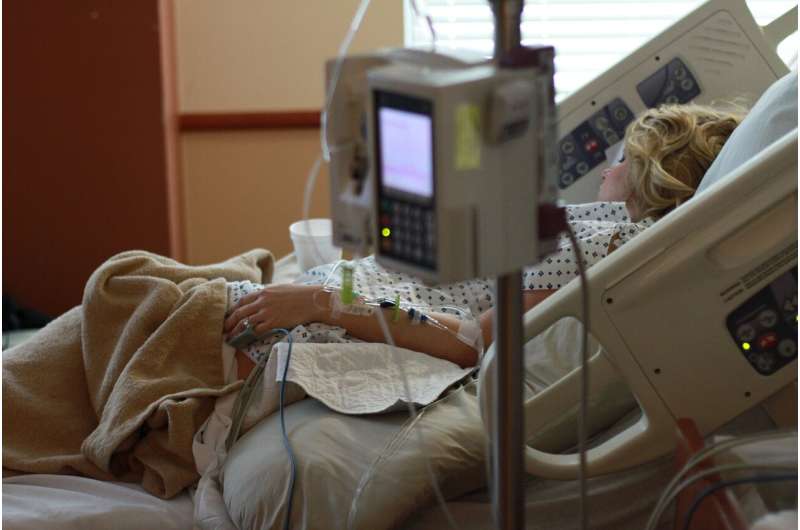Monitoring burn ICU patients requires alarm adjustments

The combination of injured skin, specialized medical care and the need to continuously monitor critically ill patients with burn injuries can make alarm management a significant challenge for burn units.
A North Carolina burn intensive care unit (BICU) successfully addressed its unit-specific concerns, as part of an organization-wide initiative to reduce excess alarms and decrease the risk of alarm fatigue.
The efforts led to a sustained decrease in nonactionable alarms and an improved alarm management strategy in the 21-bed BICU at North Carolina Jaycee Burn Center at University of North Carolina Medical Center, Chapel Hill. During each of the five data collection periods over a two-year period, the mean number of alarms per patient-day remained lower than the initial baseline.
"An Evidence-Based Initiative to Reduce Alarm Fatigue in a Burn Intensive Care Unit" details the alarm safety improvement initiative, including changes to skin preparation practices and caregiver education strategies. The study is published in the August issue of Critical Care Nurse (CCN).
Co-author Rayna Gorisek, MSN, RN, CCRN, CNL, was primarily responsible for the education of all BICU nurses, nursing assistants and respiratory therapists. During the study period, she was a clinical nurse IV at the burn center. She is now clinical nurse leader in the surgical ICU at the Durham VA Medical Center in North Carolina.
"We were able to build on institution-wide efforts and make changes to improve patient monitoring and alarm management strategies specific to the BICU environment," she said. "Even in a highly specialized BICU, the goal of reducing harm associated with clinical alarm systems is achievable and sustainable by using current evidence-based practice recommendations."
The medical center established a multidisciplinary alarm safety task force in 2015 to address The Joint Commission National Patient Safety Goal that requires hospitals to make alarm management a patient safety priority, with defined processes to identify and manage the most important alarms. The task force undertook an ongoing improvement process, testing small changes in single units and applying the learnings to test again more widely.
The BICU benefited from this collective learning but faced unique challenges related to monitoring critically ill patients with damage to their skin.
During the four-week baseline data collection period in January 2016, a mean of 110 alarms per bed, per day occurred. The overwhelming majority of the alarms met the definition for alert alarms, indicating that parameters were moving toward thresholds that would require immediate response, or a critical alarm.
In addition, the analysis showed that nearly all of the inoperative alarms were caused when the leads for electrocardiographic (ECG) monitoring were removed or lost contact with the patient.
A literature review revealed an absence of best practices to improve the adherence of ECG leads on burned tissue in an ICU setting and led to the BICU developing new skin preparation processes specific to patients with chest burns, diaphoresis or Stevens-Johnson syndrome/toxic epidermal necrolysis.
The staff aligned its alarm management strategy and education with a practice alert from the American Association of Critical-Care Nurses (AACN), "Managing Alarms in Acute Care Across the Life Span: Electrocardiography and Pulse Oximetry." AACN Practice Alerts are directives based on published evidence and guidelines to guide evidence-based nursing practice within the context of a healthy work environment.
A greater than 50% decrease in alarm numbers occurred at the first four-week collection point after the initial education intervention, but rose at the second one. Renewed emphasis on education in staff meetings, safety huddles and new nurse orientations, along with other changes, led to a decline in alarm numbers during the next collection point.
The organization-wide task force also recommended changes to the default alarm settings to narrow alarm parameters to reduce nonactionable alarms while still ensuring patient safety. All ICUs, including the BICU, implemented the new default alarm values, which likely contributed to further improvements in the BICU's alarm numbers.
"The fluctuations in alarm numbers over a two-year period emphasize the importance of understanding other factors that may be affecting the staff, including unit-level culture, work stress and leadership changes," Gorisek said.
More information: Rayna Gorisek et al, An Evidence-Based Initiative to Reduce Alarm Fatigue in a Burn Intensive Care Unit, Critical Care Nurse (2021). DOI: 10.4037/ccn2021166
















